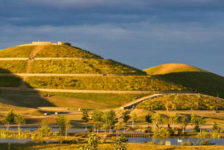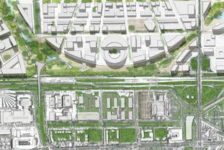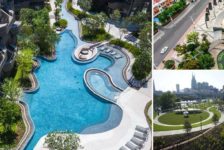Native Minnesotan Noah Billig is currently completing a Ph.D. in Planning, Design, and the Built Environment from Clemson University‘s program in Istanbul — while he is living in Vienna. I asked him why he’s moved abroad, and why he would pursue a rare “built environment” Ph.D.
What drew you to move and study overseas?
The draw overseas was really an agreement with my wife. She is a high school counselor and for a long time wanted to try the overseas international school circuit. In February, 2006, she signed up for a hiring fair in Iowa and by the end of the weekend we had signed on for two years in Istanbul.
My decision to study overseas came later that spring. I was trying to make contacts with landscape architecture and planning people in Istanbul. I saw that Clemson University had a study abroad program there, and then learned I could complete most of a Ph.D. while in Istanbul. It seemed like an opportunity I shouldn’t pass up, so I signed on.
It’s somewhat rare that an LA would pursue a Ph.D. What made you want to do this?
While in Minnesota’s Masters of Landscape Architecture / Masters of Urban and Regional Planning program I thought it would be great to end a career as an instructor at a university (after some years in professional practice), but I never thought about a Ph.D. Going to even more school seemed a bit nutty. However, the opportunity through Clemson (via Istanbul) seemed serendipitous. I also looked at the potential doors it could open down the road, particularly in academia. I discovered that if one is serious about becoming an academic researcher, the Ph.D. is a degree worth getting.
I joke that, if nothing else, the Ph.D. will make my price-per-degree go down, because the Ph.D. is funded by the university.
How will a Ph.D. help you in your future exploration of design and the built environment? What benefits will it bring to your career?
Practically, the Ph.D. will allow me to get a tenure-track position in a university or get a position at a research institute. The Ph.D. teaches how to conduct innovative, quality, peer-reviewed research. Peer-reviewed publication is often the most important criterion for advancement in an academic career (“publish or perish”). Thus, obtaining these skills is important.
I think the Ph.D. also pushes one to understand what quality research is about. This forces people to ask bigger questions: How can we obtain knowledge (epistemology)? What assumptions underlie certain systems of ideas (ontology)? What procedures can be used to really investigate a situation (methodology)? Although thinking in these terms may seem a bit esoteric to a practicing landscape architect, I think they really help establish a purpose and/or understanding when approaching real design problems. So, even if I end up in professional practice and not in academia, I think these skills are useful.
Although landscape architecture programs have the MLA as their traditional terminal degree, it does seem important that the discipline establish itself as a leader in academia and research. I think landscape architecture is the lynchpin that often holds a lot of disciplines of the built environment together (or at least it often could/should be). So why shouldn’t landscape architects be leading – or at least a part of – academic research about the built environment? In order to get on the same page as other parallel academic disciplines, the Ph.D. has to become the terminal degree for researchers. So, Ph.D.s help raise the status of the profession and discipline as a research area.
Can you give me an overview of your dissertation?
I am looking at the urban design aspects of squatter housing in Istanbul and how that can contribute to generative urban design theory (think – organic, adaptive approaches to design, planning and the built environment proposed by Christopher Alexander). Istanbul is a huge mega-city (12-20 million, depending on who does the counting). Half of the residents live in squatter housing or informal housing. However, this housing is not like the slums of Rio or Indian cities or even Cairo. Istanbul’s informal housing neighborhoods are more connected with the fabric of the city and have most of the typical infrastructure in place.
What fascinates me are the innovate forms that have emerged as a result of the squatter phenomenon there. The open spaces accommodate great social connection, economic activity, neighborhood interaction, etc – a lot of the things that proponents of “generative” urban design advocate. I think Istanbul squatter settlements can teach us something about user-based planning and design processes, adaptive responses to environmental and social factors, and how these can result in innovative and useful forms.
Specifically I am looking at two squatter settlements on the European side of Istanbul. Thirty years ago these settlements were one, but then a freeway split it in two. One settlement has stayed one and two-rise buildings with gardens and yards and a very quiet feel. The other settlement has tall apartment buildings and is very dense. It’s an interesting juxtaposition of form that can be directly connected to planning processes in the past. It also points to valid, yet different, outcomes for open space that emerge from a user-based, generative design process.
Do you plan to come back to the US, or has the wider world captured your soul for good?
I wish I knew the answer. I often find myself vacillating between desires for international living and desires to get rooted in a community. It’s hard to do both. There are a lot of factors to consider about where we will go next. We will definitely stay in Vienna through summer 2010. Our next move will likely be where I can get a job. It looks like it will be very tricky for me to get hired as an LA, planner or academic in Vienna because I am not a citizen of the European Union. However, if I do land a job we likely will stay for a few years. I’ll more likely find a job in the U.S., but if the right situation comes up for working and living abroad, it will be hard to pass up.
Traveling, studying, working and living abroad are fabulous experiences, particularly as a landscape architect. It is impossible for us LAs to look at a new city or street or vista without getting fascinated with the richness of our environment. I would guess that the wider world has captured the soul of most landscape architects that are fortunate enough to travel. Even if I move back to Minneapolis or elsewhere in the U.S., I will try to make traveling a priority for the rest of my life. And, of course, I will hopefully return to Turkey many times.
Published in Blog







Jim Del Carpio
I’m interested in pursuing a MLA/PHD. Which program or University do you recommend.
Thanks